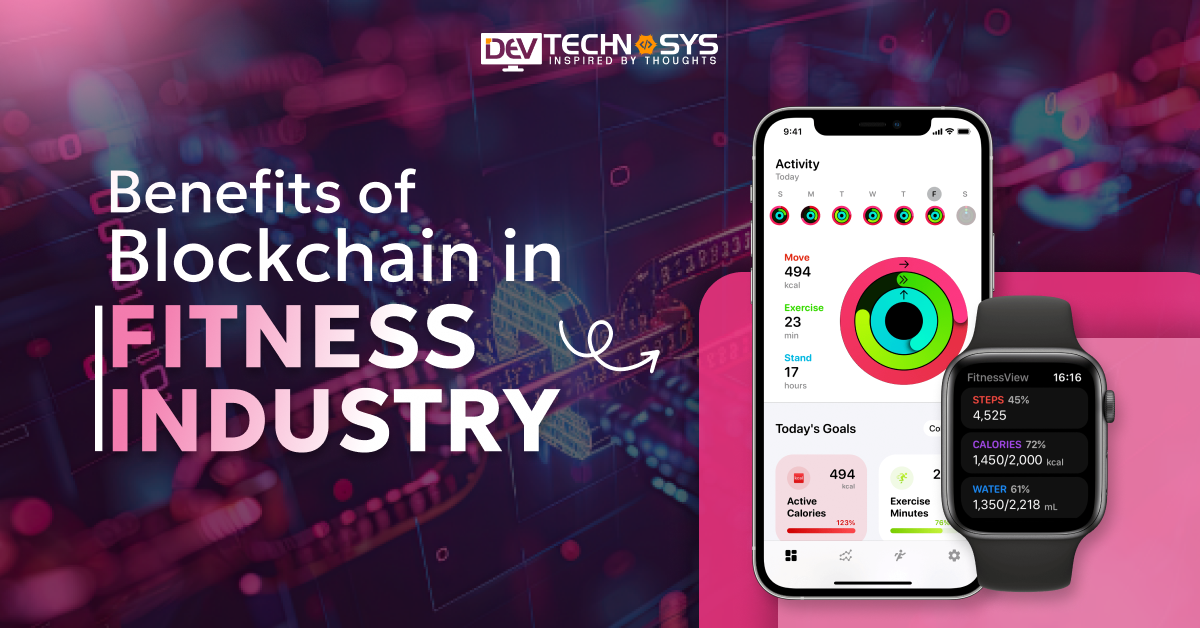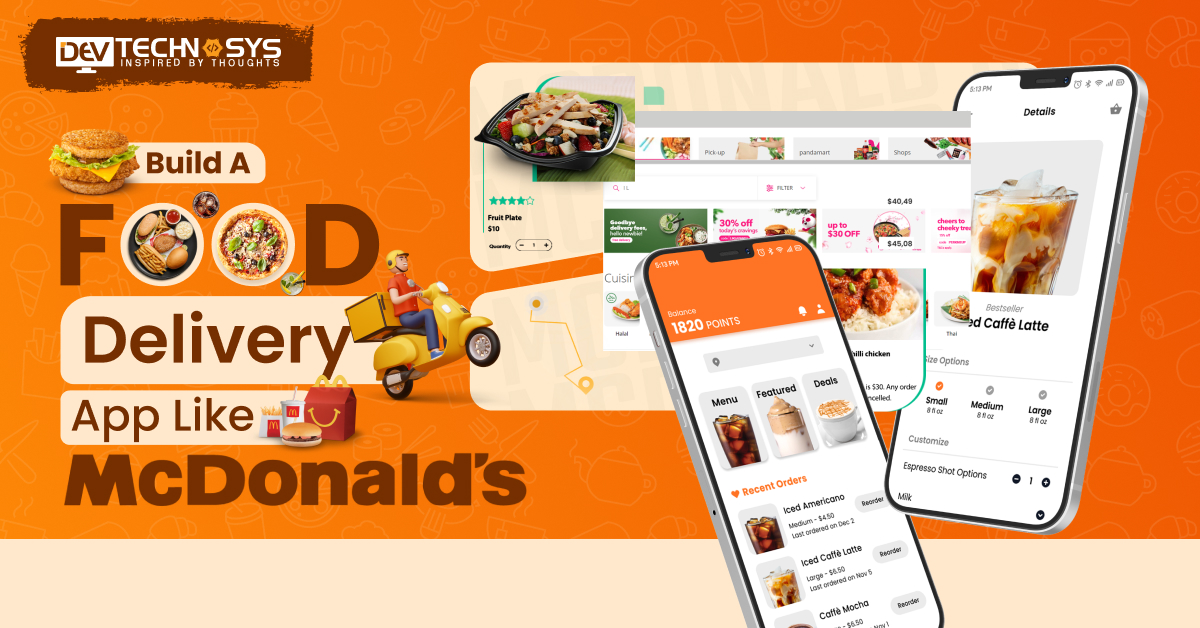I have an unyielding belief that we are on the cusp of seeing real change in various industries with the advent of blockchain technology. If there is any sector that stands to gain a lot from this change, then it is surely the fitness sector.
Whether it is about maintaining data integrity, ensuring privacy, or tracking progress and rewarding achievements, blockchain technology’s possibilities are endless.
Therefore, in the following blog, I want to discuss the various advantages of Blockchain in fitness industry . We will also examine how emerging technologies can enhance user experience within the fitness industry and improve professional data security.
So, together, let’s understand the impact blockchain will have on the fitness industry on a holistic level.
What is Blockchain In The Fitness Industry?
By presenting advancements, blockchain is changing the landscape of the fitness industry. Blockchain in fitness industry strengthens the privacy of user fitness data by preventing unauthorized access and safeguarding the information.
Blockchain technology allows the tracking of fitness goals and achievements transparently; users are paid in cryptocurrency and/or NFTs for achieving their goals.
Furthermore, It provides speed and security during the payment process, enhances membership organization, and improves the general fitness experience for the user.
Popular Blockchain Integrated Fitness Apps 2025
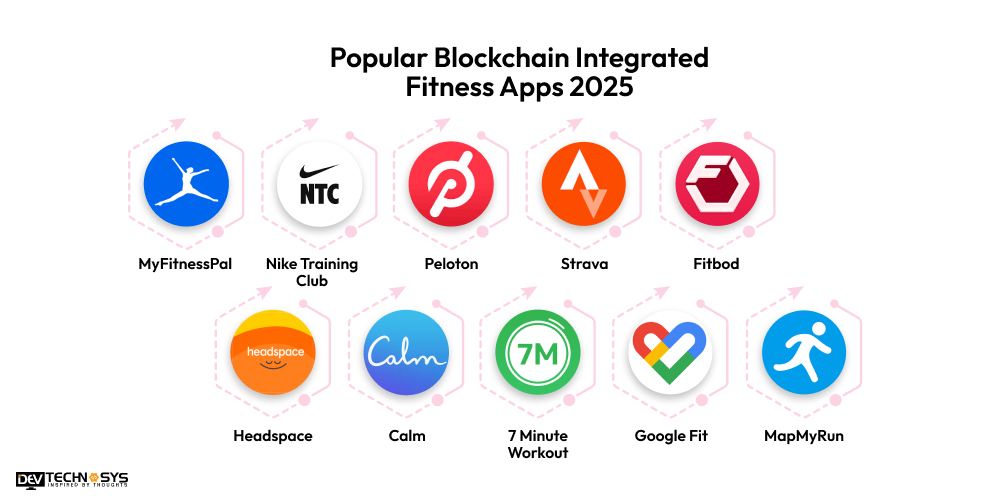
App Name |
Downloads (Approximate) |
Launch Year |
Platforms |
| MyFitnessPal | 100+ Million | 2009 | Android, iOS, Web |
| Nike Training Club | 50+ Million | 2009 | Android, iOS |
| Peloton | 50+ Million | 2012 | Android, iOS, Web |
| Strava | 50+ Million | 2009 | Android, iOS, Web |
| Fitbod | 10+ Million | 2016 | Android, iOS |
| Headspace | 10+ Million | 2010 | Android, iOS, Web |
| Calm | 10+ Million | 2012 | Android, iOS, Web |
| 7 Minute Workout | 10+ Million | 2013 | Android, iOS |
| Google Fit | 100+ Million | 2014 | Android, iOS, Wear OS |
| MapMyRun | 50+ Million | 2009 | Android, iOS, Web |
10 Use Cases of Blockchain In Fitness Industry 2025
Hooray, the movement has come when you should know the blockchain in fitness industry use cases. Here, we have compiled all of the amazing use cases you need to consider before investing. So dive.
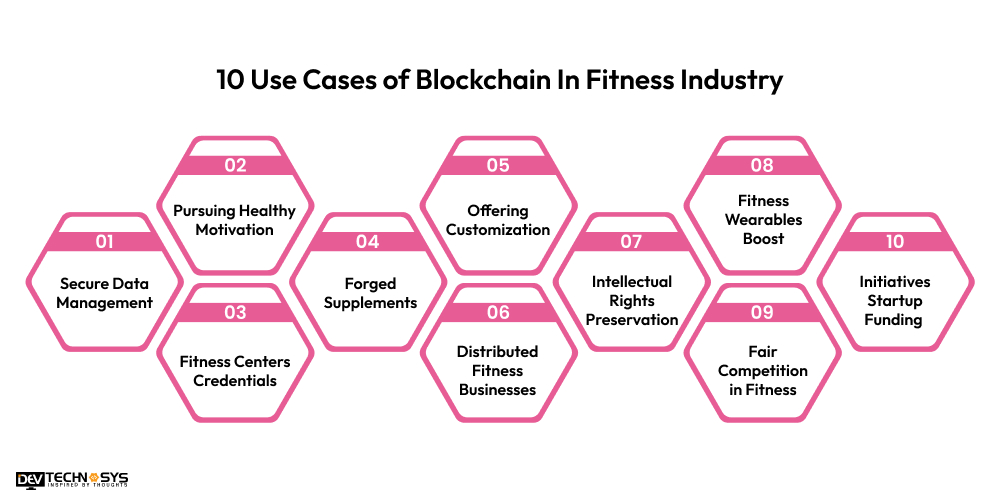
1. Secure and Transparent Data Management:
Blockchain has the potential to change the approach to fitness data storage. By using a decentralized ledger, all workout data, medical records, and fitness targets can be kept in a single place that is safe and secure.
This guarantees privacy, protection from abuse, and control of personal data. Selective data access can be created and given to trainers, doctors, or other authorized users without losing data ownership. Connect with a fitness app development company if you want to invest now.
2. Motivation for Pursuing Healthy Habits:
Blockchain has the potential to promote healthy activities by offering tokenized rewards. For example, people can earn tokens when they complete a workout, reach a fitness goal, or participate in a workout challenge.
These tokens can be redeemed against gym membership, fitness equipment, or healthy food. This makes fitness a game and encourages people to be active.
3. Authentication of Gyms or Fitness Centers Credentials:
Blockchain is a powerful tool for creating and implementing reliable systems for validating ideas regarding living things’ fitness credentials.
The concept of fitness certifications, licenses, and even details of issued training can easily be put in the blockchain to secure their content and avoid fraud.
This will help both fitness professionals and the market increase the degree of trust and transparency in the industry. If you’re developing a blockchain app solution but looking for authentication, blockchain can help you.
4. Fight Against Forged Supplements:
There is a great risk in using forged supplements, as they can have negative health impacts on users. However, blockchain technology can solve this problem by providing a clear supply chain.
Each product can be traced from its source to the buyer, verifying its genuineness and quality. This helps ensure that users are not consuming harmful products and fully places trust in the supplement market.
5. Offering Tailor-made Fitness Business:
What blockchain will do is have each user registered with a unique digital identity that will allow for tailored business solutions, and that data will be safe as it is decentralized.
Such data can suggest appropriate workout routines, nutrition requirements, and other fitness goal assistance via blockchains. Such particular details can enhance the level of engagement with customers and also provide better results with the help of Polygon blockchain development.
6. Building Distributed Fitness Businesses:
There is scope to set up community-owned and managed decentralized fitness businesses, and blockchain will help in this area. Users can enroll in a variety of fitness programs that include group classes, one-on-one training, and meal planning.
Through the use of cryptocurrency, users can book services from trainers with no free added intermediaries.
7. Preservation Of Intellectual Property Rights:
Professionals in fitness app development have an opportunity to protect their intellectual property, such as customized workout routines, fitness programs, and training methodologies, using blockchain technology.
By storing their tangible creations on a blockchain, they can define ownership and restrict use and reproduction without permission. Such measures can promote more revolution and creativity in the fitness space.
8. Improvement of Fitness Wearables:
With Blockchain in fitness industry , the integrity of user data of fitness wearables can be significantly improved through safe offshore storage. Data collected from users can be directly embedded within the decentralized system, preventing unauthorized access.
This can also facilitate extra features like secure data collection with healthcare professionals and fitness programs built on the spot by real-time analytics with fitness website development.
9. Promoting Fair Competition in Fitness Challenges:
The implementation of Blockchain in fitness industry could improve the participants’ expectations of accuracy in reporting fitness challenges. It becomes possible to record results into a system of records with high assurance, ensuring that those records can never be edited out. This can minimize the likelihood of fraud and foster confidence among participants and organizers.
10. Startup Funding in Fitness Initiatives:
A solution using blockchain technology in fitness app development can encourage the other side to invest in new technology in fitness equipment, studios, or other innovations through a new national platform. This can open up opportunities for entrepreneurs who need funds and investors who can now take up a share of the fitness market.
So, if you’re ready to invest in mobile application development for the fitness industry, invest in blockchain technology.
What is The Benefits of Blockchain in Fitness Industry?
Now that you know the use cases of Blockchain in fitness industry in 2025, you must thoroughly explore its benefits. Here are some benefits of blockchain and IoT fitness development, so dive into this section.
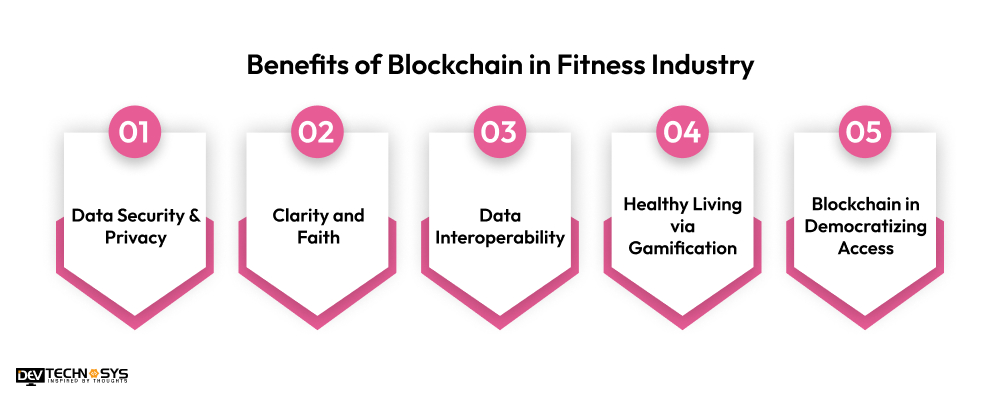
1. Enhanced Data Security and Privacy:
Health apps and trackers often require their users to upload or input sensitive workout, health, and personal information. However, blockchain’s decentralized and distributed ledger can fortify the security of such information.
The information belonging to the users is encrypted and dispersed on the different nodes, meaning it will take a lot to breach or manipulate it. This translates to more security and user control over the information they provide.
2. Enhanced Clarity and Faith:
The use of blockchain technology would enhance trust and transparency in the fitness app development sector. For example, fitness centers can utilize blockchain to authenticate the equipment for credibility so customers get genuine and safe products. Additionally, trainers can trust potential clients by utilizing blockchain to showcase their credentials and certifications.
3. Enhanced Data Interoperability:
The application of fitness data is usually confined to the boundaries of individual apps and devices, hence making it hard to share and analyze through different platforms.
Blockchain in fitness industry has the potential to enhance data interoperability by providing a secure and unified infrastructure for sharing various types of fitness data. This means users can access all their fitness devices and applications to get a broader perspective of their health and fitness advancement.
4. Rewarding Healthy Living via Gamification:
Healthy living can be fun, and being fit can now be gamified through blockchain and its tools in the fitness industry.
Users from dapps development in blockchain can now be given rewards ranging from cryptocurrency to having exclusive rights to fitness content when they complete workouts, set fitness targets, or participate in fitness challenges. This gamification aspect can make fitness more engaging and motivating for individuals.
5. Blockchain in Democratizing Access to Fitness Services
Blockchain can make access to fitness services fairer in health and fitness since such technology allows for the development of democratic-based platforms.
Through these platforms, people who would like to train or take some classes can meet qualified trainers and coaches worldwide without considering their physical location or economic standing.
This has the potential to improve the availability of affordable and good fitness teaching, helping many people meet their desired fitness objectives.
Challenges of Blockchain in the Fitness industry
Now that you know the benefits and uses of blockchain in health and fitness, you will see just how challenging that is. In this section, we have covered some incredible challenges that come with using blockchain in healthcare app development.
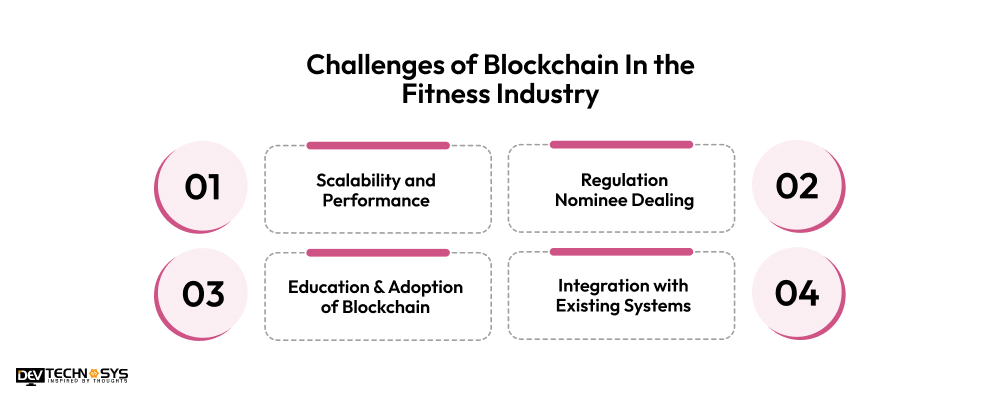
1. Scalability and Performance:
Issue: Most existing blockchain real-time systems cannot scale as required and offer real-time processing of the dynamic fitness markets.
Effect: Experienced delays typically result in low transaction speeds, which is quite an indelible barrier for many users, especially in real-time fitness tracking and data exchange.
Mitigation: This challenge will require further research and development aimed at finding more effective and scalable blockchain solutions, including shard and layer-2 scaling solutions.
2. Uncertainties in Regulation Nominee Dealing:
Issue: The regulation of blockchain in health and fitness has not yet been settled in many regions.
Effect: Such uncertainty can pose legal and regulatory challenges to fitness sector businesses and slow down the rate of adoption and deployment of blockchain technologies.
Mitigation: More Unambiguous regulations and guidelines should be implemented to allow business firms legal certainty and the governance manner in which blockchains will be integrated.
3. User Education and Adoption of Blockchain:
Issue: Many consumers lack a basic understanding of blockchain technology’s workings and extensive benefits.
Impact: Blockchain in health and fitness applications might face poor acceptance simply because users do not fully comprehend how these functions work.
Mitigation: Educational marketing and optimization of the interface are important to meet more consumer requirements for blockchain technology.
4. Integration with Existing Systems:
Issue: Integrating blockchain in health & fitness and operation into existing fitness systems, like gym systems, health trackers, or health management systems, can be complicated and tedious.
Impact: Integrating information systems with any significant change hinders the smooth integration of user-centric fitness solutions within their ecosystems. It also greatly limits the usages and features that one could achieve.
Mitigation: To integrate blockchain platforms with existing systems, Developing APIs and integration frameworks with the existing ones can effectively make interoperation possible.
Cost of Developing Blockchain in the Fitness Industry
The cost of developing blockchain in fitness varies from $10,000 to $30,000. However, it is vital to keep in mind that the cost varies depending on multiple factors affecting the entire process, including complexity, blockchain app development company size, features, integration, and more. Here is a list of everything you need to know.
1. Complexity of Features:
The more complex the features, the higher the blockchain app development cost. This includes the number of features, their complexity, and the level of customization required.
Feature Complexity |
Cost Range |
| Basic Tracking (steps, calories), Simple Rewards | $8,000 – $12,000 |
| Advanced Tracking (sleep, heart rate), Social Features (basic), Limited Tokenization | $12,000 – $15,000 |
| AI/ML Integration (personalized plans), NFT Rewards, Decentralized Governance, Complex Integrations | $15,000 – $25,000 |
2. Blockchain Integration:
The extent of blockchain integration significantly impacts the blockchain app development cost. Basic tokenization will be less expensive than complex decentralized applications with advanced smart contracts.
Blockchain Integration Level |
Cost Range |
| Basic Tokenization, Simple Rewards | $8,000 – $12,000 |
| NFT Integration, Advanced Rewards Systems | $12,000 – $18,000 |
| Decentralized Governance, Complex Smart Contracts, DeFi Integration | $18,000 – $25,000 |
3. Platform Choice:
It is vital to know that the cost also varies depending on the platform. Developing for multiple platforms (iOS, Android, web) increases the time and the blockchain app development cost.
Platform |
Cost Range |
| Single Platform (iOS or Android) | $8,000 – $15,000 |
| Two Platforms (iOS and Android) | $12,000 – $20,000 |
| Multi-Platform (iOS, Android, Web) | $15,000 – $25,000 |
4. Design and User Experience:
A high-quality user interface and user experience require skilled designers and developers, which can increase costs.
Design Complexity |
Cost Range |
| Basic Design, Minimal Customization | $8,000 – $12,000 |
| Modern and Intuitive UI/UX, High-Fidelity Prototyping | $12,000 – $18,000 |
| Bespoke Design, Unique User Experience, Extensive User Testing | $18,000 – $25,000 |
5. Development Team:
The cost of development varies depending on the location and experience of the enterprise mobile app development company. Hiring in-house developers or outsourcing to agencies can significantly impact costs.
Team Structure |
Cost Range |
| Junior Developers, Freelancers | $8,000 – $12,000 |
| Mid-Level Team, Small Agency | $12,000 – $18,000 |
| Senior Developers, Experienced Agency | $18,000 – $25,000 |
These are general estimates. The actual cost will depend on your project’s specific requirements. You should consult with an AI development company for a detailed cost assessment and project roadmap.
How To Monetize Blockchain in the Fitness Industry ?
Blockchain can be applied in the fitness industry in various ways to generate revenue. In this section, we have covered some revenue-generating ways Blockchain can be used in the workout industry.
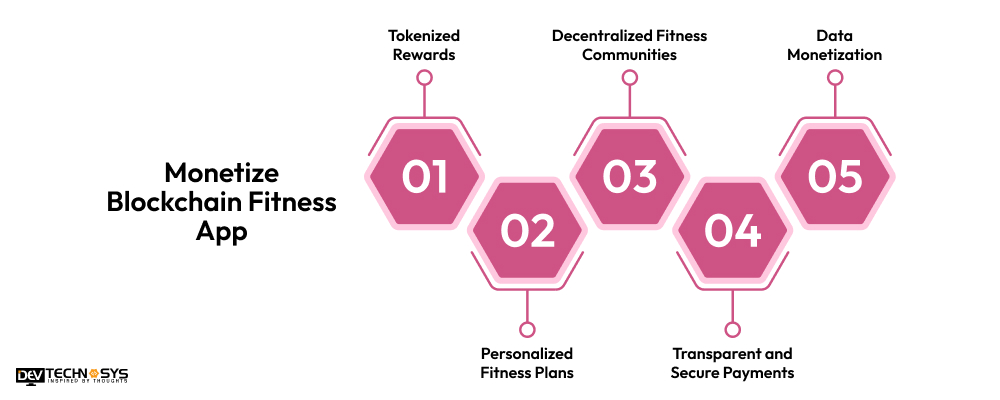
1. Tokenized Rewards:
Fitness platforms can offer digital tokens as rewards for exercising, attending a workout class, or achieving specific targets. Users can use these tokens to get discounts on gym memberships, exercise equipment, and special content.
Connecting with a leading yoga app development company will provide you with a secure application and some functions you just need to add for success.
2. Personalized Fitness Plans:
Blockchain in the blockchain workout industry provides a means of safely storing and sharing fitness information.
This allows training programs, diet plans, and fitness recommendations to be tailored specifically to personal data.
There is a potential for monetizing access to such advanced personalized plans on a subscription or token-gated basis.
3. Decentralized Fitness Communities:
Blockchain in the workout industry makes building decentralized fitness communities easier for users to interact, share experiences, and embark on fitness challenges.
Membership fees, participation at exclusive events organized by the community, and fitness-related content created by members might generate revenue.
4. Transparent and Secure Payments:
Blockchain technology in workout app development increases security and transparency in financial transactions.
Intermediaries are no longer needed in payment processing, and thus, transaction fees are reduced. This may appeal to users and increase efficiency in the operations of fitness businesses.
5. Data Monetization:
The fitness data obtained from the blockchain-enabled systems can be helpful in studies, targeted advertisements, and the creation of new fitness products or services.
Fitness companies can exploit such information by entering into secure and ethically acceptable data monetization agreements with researchers and advertisers, among other beneficiaries.
Conclusion
Blockchain technology benefits the fitness industry, including increased data security, transparent reward systems, and innovative new membership models. At Dev Technosys, we are a fitness-centric business. We build innovative blockchain solutions that respond to the needs of this industry.
Our enterprise mobile app development company’s extensively qualified staff will assist you in every aspect of your project, ranging from concept and development to implementation and maintenance.
We want to help you reposition your fitness company using the strategies outlined above and blockchain technology to make it easier for your customers to engage with it.
Frequently Asked Questions
1. How Much Does It Cost to Develop a Blockchain in the Fitness Industry ?
The cost of developing Blockchain in the workout industry can range from $8,000 to $25,000, depending on the functions needed, the difficulty of solving the problem, and the required hours. A detailed consultation can provide an appropriate estimate.
2. How Long Does It Take to Develop a Blockchain in Fitness Industry ?
Creating a rewards app for working out suited for the needs of the fitness industry typically takes 3 to 6 months. The duration of the project will vary based on the system’s advanced features and how robust, effective, and scalable the solution needs to be.
3. Why Choose Dev Technosys to Develop Blockchain in the Fitness Industry ?
We have over 14 years of experience providing creative, safe, and expandable strategies for blockchain technology. Our specialists guarantee secure integration with all existing systems, customized functionality, and unwavering security, making us a reliable fitness industry solution provider.
4. What Are the Benefits of Blockchain in the fitness industry ?
Blockchain enhances data security, ensures transparency, enables decentralized management, supports fitness rewards, and facilitates seamless payments. It empowers businesses to build trust and improve user engagement effectively.
5. How Can You Monetize Blockchain in Fitness?
Monetize Blockchain through tokenized rewards, subscription services, data-sharing partnerships, transaction fees, and fitness challenges. Leveraging blockchain-powered smart contracts can also create new revenue streams.
6. How Much Will It Cost to Maintain Your Blockchain in the Fitness Industry?
Maintenance costs range from $2,000 to $5,000 annually, depending on infrastructure, updates, and scaling needs. Regular maintenance ensures optimal performance, security, and compliance with evolving industry standards.
